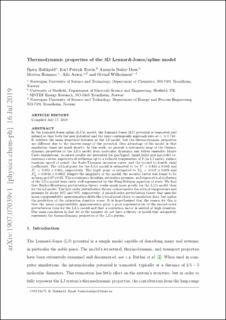| dc.description.abstract | In the Lennard-Jones spline (LJ/s) model, the Lennard-Jones (LJ) potential is truncated and splined so that both the pair potential and the force continuously approach zero at rc ≈ 1.74σ. It exhibits the same structural features as the LJ model, but the thermodynamic properties are different due to the shorter range of the potential. One advantage of the model is that simulation times are much shorter. In this work, we present a systematic map of the thermodynamic properties of the LJ/s model from molecular dynamics and Gibbs ensemble Monte Carlo simulations. Accurate results are presented for gas/liquid, liquid/solid and gas/solid coexistence curves, supercritical isotherms up to a reduced temperature of 2 (in LJ units), surface tensions, speed of sound, the Joule-Thomson inversion curve, and the second to fourth virial coefficients. The critical point for the LJ/s model is estimated to be T ∗ c = 0.885 ± 0.002 and P ∗ c = 0.075 ± 0.001, respectively. The triple point is estimated to T ∗ tp = 0.547 ± 0.005 and P ∗ tp = 0.0016 ± 0.0002. Despite the simplicity of the model, the acentric factor was found to be as large as 0.07±0.02. The coexistence densities, saturation pressure, and supercritical isotherms of the LJ/s model were fairly well represented by the Peng-Robison equation of state. We find that Barker-Henderson perturbation theory works much more poorly for the LJ/s model than for the LJ model. The first-order perturbation theory overestimates the critical temperature and pressure by about 10% and 90%, respectively. A second-order perturbation theory that uses the mean compressibility approximation shifts the critical point closer to simulation data, but makes the prediction of the saturation densities worse. It is hypothesized that the reason for this is that the mean compressibility approximation gives a poor representation of the second-order perturbation term for the LJ/s model and that a correction factor is needed at high densities. Our main conclusion is that we at the moment do not have a theory or model that adequately represents the thermodynamic properties of the LJ/s system. | en_US |
